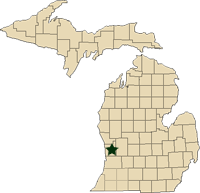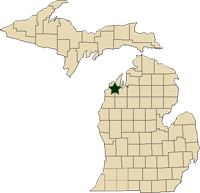Regional reports on Michigan fruit – May 15, 2012
MSU Extension educators’ pest and fruit updates for Michigan.
This week’s regional reports:
- Southwest Michigan - Mark Longstroth, Bill Shane, Diane Brown
- Southeast Michigan - Bob Tritten
- Grand Rapids Area Tree Fruit - Amy Irish Brown and Phil Schwallier
- Grand Rapids Area Small Fruit – Carlos García-Salazar
- Northwest Michigan - Nikki Rothwell, Duke Elsner, Erin Lizotte
Southwest Michigan – Mark Longstroth, Bill Shane, Diane Brown, Michigan State University Extension
Weather
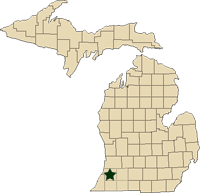
Southwest Michigan

Southwest Michigan
Last week was warmer with lows in the 40s and highs in the 60s and 70s. There were some light frosts Thursday morning (May 10), which caused little damage. Rain fell on Monday (May 7) and Saturday (May 12). Saturday’s rain was generally a daylong drizzle that resulted in an infection event for most crops. Most areas received less than an inch of rain for the week.
Soils are generally moist, but beginning to dry out, especially sandy soils. Weather for this week is forecast to be into the upper 70s with lows in the 50s. Our growing degree day accumulations are currently more than two weeks ahead of normal for this time of year.
|
Southwest Michigan Growing Degree Day Totals from January 1 through May 13 | |||
|
Location |
GDD 42 |
GDD 45 |
GDD 50 |
|
840 |
689 |
471 | |
|
793 |
648 |
441 | |
|
756 |
609 |
400 | |
Tree fruit
Damage from April freezes is easy to see. The few fruit are clearly visible. Tree fruit is scarce. Finding fruit to measure for this report is a chore. Most growers without a crop have switched to minimal sprays to maintain tree health. MarketMaker is a source for finding other growers who can help provide fruit this season. Search the National Market Maker database at the MarketMaker homepage and click on any state you want to search. If you need help doing the search, watch a brief YouTube video on how to find a business on MarketMaker. Growers who direct market fruit to the public are calling other states to find a source of fruit for their stands and markets.
Apricots are scarce. The few fruit are an inch to 1.25 inches in diameter.
Peach fruit are 16 to 22 mm in diameter. Smaller fruit are often hollow with the seed cavity empty. We expect this fruit to fall. Oriental fruit moth catches declined last week, indicating the first flight has peaked. No flagging of terminal ends by burrowing larvae has been reported. Treatments should be maintained in young peach orchards (first to third leaf) to avoid the disfiguring effects of larvae feeding on shoot tips. Tarnished plant bugs are present on flowering weeds in orchards and could cause cat-facing of fruit. Moderate amounts of bacterial spot symptoms are showing up on leaves, especially on susceptible varieties.
Sweet cherry pits are hard and fruit are about 14 to 16 mm in diameter. Viable fruit are generally scarce in orchards with fruit. There are also red fruit where the flesh was frozen, but the seed was not killed. The fruit surface pitted from frost is common. Growers with fruit should protect against plum curculio and brown rot.
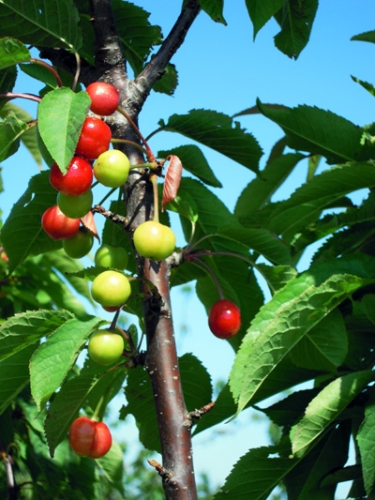
The flesh of the red cherries was damaged by the late
April
freeze and the damaged fruit is ripening prematurely.
Tart cherry fruit are about at 12 mm and pits are hard. Most orchards have little, if any, crop. Growers should control cherry leaf spot to maintain the health of their trees. ProGibb (GA3) is useful as a treatment post-shuck off to avoid excessive flowering next year.
Plums are hard to find. Protect against black knot as long as the shoots continue to grow. Leaf spotting and shot holes from bacterial infections are common.
Apple orchards have little fruit. Orchards in good sites have a light crop. Apple fruits are about 12 to 22 mm, depending on when that variety bloomed. Frost rings and russeting are common on fruit. The cool weather is enhancing leaf symptoms of apple mosaic virus, especially on Banning Fuji, which is notorious for having this virus, even in nursery stock. Apple scab symptoms can be found in some orchards. Scab ascospores are declining and the Enviro-weather model for apple scab indicates that about 95 percent of the spores have been released.
Codling moth was caught in good numbers in some sites last week and a generally conservative biofix was set as May 7. Fireblight symptoms can be found in a few orchards. A year like this with no diseases is an excellent time to prune fire blight out. Apogee is being used to manage shoot growth.
Pears need to be protected against pear scab. Pear psylla is present in low numbers.
Small fruit
In grapes, vineyards are greening up again and growth is visible now even from a distance. New shoots in Concord and Niagara are 6 to 8 inches long. Many of these shoots have a single flower cluster or one larger cluster and one very small cluster.
Wine grape shoots are at a similar stage of growth, but generally have much higher cluster counts. Vineyards with exposed flower clusters need protection against phomopsis. Grape berry moth trap catches declined slightly last week. Bloom in black locust (Robinia pseudoacacia) is a good, visual clue to bloom in wild grapes. When black locust reaches full to late bloom, check the progress of bloom on wild grapes. Biofix for grape berry moth is defined as 50 percent bloom on 50 percent of clusters of wild grapes (Vitis riparia). We reached biofix in the southern part of Berrien County at the end of last week, and expect to reach biofix sometime this week in northern Berrien and Van Buren counties.
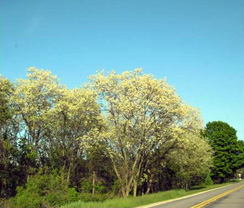
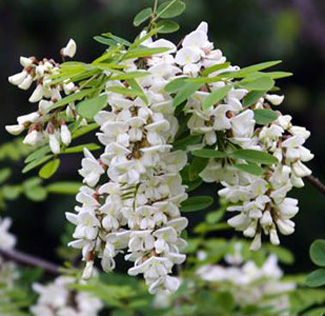
Left, black locust at full bloom in southwest Michigan, taken May
11, 2012.
Right, black locust flower clusters. Photo credit: Ohio State
University.
Grape flea beetle larvae were found feeding on foliage. Damage is minor and does not generally warrant control, unless the population and damage is high.
Blueberry bloom is ending. Fruit set is variable, but much better than in other fruits. The largest fruits are the size of peas. Some blueberry fields were damaged by the freezes in April with freeze injury to leaf buds. These fields are easy to see from the road. They look extremely ratty with scattered foliage on the bushes. Fortunately, new growth is beginning on many of the affected canes. Soils in some fields are beginning to dry while many others have standing water in the ruts between the rows. Blossom blights are widespread, but not generally serious.
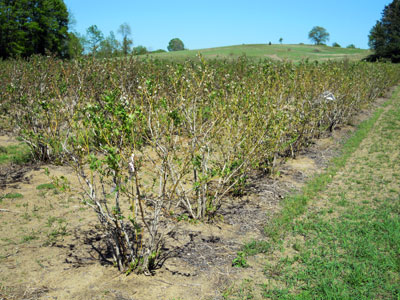
This ‘Bluecrop’ field had many of the leaf buds damaged by the
early April freezes and now the bushes are growing new leaf buds.
Growers should control anthracnose at the green fruit stage. Scouts have been catching both cherry fruitworm and cranberry fruitworm. For more scouting information, see the Blueberry Insect Scouting Report from May 14, 2012.
Strawberry bloom is ending in June bearing varieties and the largest fruit is thimble- sized. Ripe fruit is being harvested from raised beds in high tunnel strawberry plantings. Growers should be checking for angular leaf spot caused by the wet cold conditions. Small amounts of common leaf spot can be found in field plantings. Tarnished plant bug adults have been detected in low numbers. Both nymphs and adults feed, but nymphs cause the most damage. Feeding damage from this insect causes button berries, but freeze damage and poor pollination can also produce similar symptoms. See the related MSU Extension article Managing tarnished plant bug injury to strawberries on monitoring for tarnished plant bug nymphs.
In brambles, bloom is beginning in early varieties. Plants show leaf scorching from recent freezes. Significant losses in blackberries and some early blooming red raspberries have been reported. Damage is easier to see and assess with warmer temperatures this week.
Upcoming meetings
Our next Monday fruit meeting will be May 21 at Fruit Acres Farms at 5 p.m. Fruit Acres Farms is located on the northeast corner of Friday and Carmody Roads, about 1.5 miles south of the Coloma Exit on I-94. One RUP credit is available at the meeting.
The next in-season grape meeting will be May 23 from 6 to 8:30 pm. at Cronenwett Farms, 70121 28th St., Lawton, Mich. (see directions). The $15 registration fee includes supper and 2 RUP credits. Topics to be covered include weed control comparison plots, current insect and disease control considerations for reduced crops and canopy management adjustments for reduced /no crop situations. Please RSVP to the Berrien County Extension office in advance (1-269-944-4126) if you plan to attend so we can have accurate counts for supper. On-site registration will be available.
Southeast Michigan – Bob Tritten, Michigan State University Extension
Weather
|
|
Growers continue to assess fruit damage and crop loss from the April 27 and April 29 freeze events. Many tree fruit growers have decided that there is so little fruit remaining in most blocks that they will be moving to a minimal pest control program for the remainder of the season. As I stated in last week’s report, there has been a significant crop loss in all tree fruits across the region.
The only bright spots I can find in the east Michigan fruit industry are that the severity of the last freeze event was less in the southern tier of Michigan counties and that our blueberry crop has moved through these freeze events in good shape with a good crop coming along. There are still a few apples and peaches remaining on trees in the Romeo, Mich., area. Tree fruit crops to the southernmost tier of counties have between half and three-quarters of an apple crop, and fewer peaches.
A second week with warmer temperatures has spurred on a good amount of new growth in most of our fruit crops, with the exception of peach foliage, which still has a thrifty appearance to it. Our early warm season is still running about two weeks ahead of normal in terms of growth stages, and even more than that in terms of degree day totals. The 10-day forecast is showing that there is a slight potential for a mild frost event on Wednesday evening (May 16) and Thursday morning (May 17) of this week. Once we are through this time, we are nearing an end of the time that we are vulnerable to frost and freeze events.
Most of the region received two to three rain events over the past week; however, we received very little measurable rain over this same time, with most farms receiving only a few tenths of an inch of rain. Our soils now have an adequate amount of soil moisture. Newly plant fruit crops have put on a fair amount on new growth in the past week.
|
East Michigan Growing Degree Day Totals for March 1 to May 14 | |||
|
Location |
GDD42 |
GDD45 |
GDD50 |
|
736 |
589 |
384 | |
|
698 |
557 |
359 | |
|
Flint (Genesee) |
771 |
625 |
419 |
|
764 |
621 |
416 | |
|
824 |
668 |
448 | |
|
633 |
497 |
315 | |
|
734 |
587 |
379 | |
Tree fruits
Apples that were not killed from the freeze event of April 29 were very hard to find yesterday (May 14), making it hard to determine the stage of development or fruit size. Most apple blocks have no viable fruit that survived the April 29 freeze event. Apples in the southern part of the region are mostly between 12 and 16 mm in size. Most apple trees have between 4 and 6 inches of new growth. A good number of farms have used Apogee in the last week to try to contain new growth.
I continue to see a fair amount of newly opened apple blossoms in a few varieties in the last week. These are tertiary (or third in order of king and side bloom being first, then secondary bloom on 1-year-old wood) blossoms or what most growers refer to as “rag tag” bloom. While some of these blossoms may make it to harvest, they will be very poor quality fruit, and the low number of these fruit are not economical to control pests for the remainder of the season.
Growers continue to ask questions about which pests need to be controlled when there is little to no apple crop. Here is my list of the five major pests that I would like to see monitored or controlled:
- Apple scab through the end of primary apple scab season (see more details as you read forward).
- Fire blight if you have a trauma event (hail or strong winds) and on young trees.
- Powdery mildew on susceptible varieties.
- Codling moth if you have even a few fruit.
- Mites.
Codling moth adult catches have risen sharply at most farms in the past week, with trap catches at most farms being in the range of 30 to 50 moths per trap. Most growers set a biofix last week; I set the regional biofix date of May 10. Plum curculio fruit stinging is now being seen. Mullen bug adults have been found in a few apple blocks.
Oriental fruit moth trap catch has dropped off considerably in the last week as first generation adult flight is ending. I continue catching them only in apples, however, and none in peaches, which is odd. I set a regional biofix for oriental fruit moth of April 19.
A few tarnished plant bugs are being seen in apples and other tree fruit. I have seen a few more potato leafhoppersw in the last week. I continue to see a few aphid species, including apple grain aphids, rosy apple aphids and woolly apple aphids. Leafroller larvae numbers are generally declining. European red mites are hatching, with egglaying just starting to be seen. Two spotted spider mite adults are being seen in low numbers, with egglaying occurring already. Predators are being found in good numbers for this time of the season, including green and brown lacewing adults, solider bugs, minute pirate beetles, ladybird beetles, Stethorus beetles and A. fallacis mites.
Most fruit farms have had two to three apple scab infection periods in the past week. Growers will need to continue apple scab control until the end of primary apple scab season, even if they have no crop. I am now seeing both leaf and fruit scab in only a few orchards. We continue to catch apple scab spores at both of our monitoring stations with each wetting event, with the number of spores declining with each rain event. The apple scab maturity model is predicting that all apple scab spores are now mature, but we need more moisture for them to be released. Depending on rainfall, I expect the end of primary apple season to occur in the next week or so.
Pears have dropped all of their fruitlets in most blocks, with the exception of winter pears growing in the southern part of our region. Pear psylla adults continue to fly, with heavy egg hatch particularly in the tops of trees. Pear psylla populations will need to be controlled where there is no crop this year.
Peaches have no viable fruit remaining at many farms and at others a very light crop in a few of the varieties. Some of the fruit that remains on the tree is not swelling in size, which is not a good sign. Oriental fruit moth trap catch is down. I set a regional biofix for oriental fruit moth of April 19. Green peach populations are now increasing. For trees with no crop, this year is a good opportunity to do some major pruning to reduce tree height. Be careful not to remove more than a quarter of the leaf surface.
Sweet cherry fruit damage was extensive from the April 29 freeze event, with very little to no viable fruit remaining. Cherry leaf spot disease needs to be controlled in blocks that do not have a crop and maybe cherry fruit fly in problem blocks.
Tart cherry fruit damage was extensive, with little to no crop remaining at most farms. Cherry leaf spot disease needs to be controlled in blocks that do not have a crop.
Plums were severely damaged by the last freeze event. Most blocks have little to no viable fruit.
Small fruits
Strawberries are at petal fall to thimble-sized fruit at most farms. Berries are starting to color at farms in the southern part of the region. Berry harvest is expected to begin around May 25-28 in the south, May 30 to June 3 for farms north of Detroit and a few days later for farms in the Thumb. This will be the earliest that some farms have ever opened for harvest.
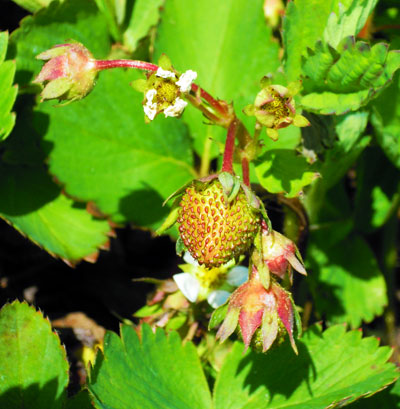
Earliglo strawberries the size
of a thimble. Photo credit: Mark Longstroth, MSUE
I had a report this morning (May 15) from one strawberry grower picking just a few ripe berries growing on the end of a row. Over the weekend I started to see evidence of slugs moving about in strawberries. Growers need to do a good job of scouting for them. I have not seen any new strawberry clipper damage in the last week. The final gray mold fungicide application is being made at this time where there is bloom remaining. No new angular leaf spot disease symptoms have been seen in the last week. Growers need to keep a close eye out for this disease, and be ready to control it if the need arises.
Raspberry leaves continue to emerge for summer fruiting types and new canes continue to emerge from the soil for fall bearing types. Flower buds are just now visible on summer fruiting types. There is extensive tip burn or dieback from our freezes on summer fruiting types at many farms. Fall bearing raspberries are sending up a new set of canes where they were damaged from earlier freeze events, with fall raspberry canes being 5 to 8 inches in length.
Blueberries are at petal fall to late bloom for most varieties. Blueberry flower buds appear to be in good shape in terms of crop loss from freeze events. The next week or so will tell the story if there was any freeze damage in blueberries. I am seeing a few low-lying sites where there has been some freeze damage. Phomopsis canker infected canes are now visible at many farms. Keep an eye out for mummy berry disease and Phomopsis canker in frost-protected blocks.
Grapes were at bud burst when the April 29 freeze event occurred, and are now starting to show signs of that regrowth. Flower buds are now visible on several varieties. Some canes that were damaged in the many freezes appear to have been killed. I would wait for a few weeks to remove those canes, however, for any signs of emerging buds.
Grand Rapids Area Tree Fruit– Amy Irish Brown and Phil Schwallier, Michigan State University Extension
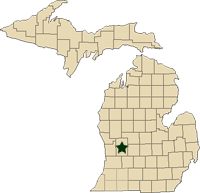
Grand Rapids Area

Grand Rapids Area
Crop update
Growers are still assessing crop damage for all tree fruits, and the prospects are looking bleaker every day for most tree fruits. Apples seem to be the hardest hit by the freezes on April 27 and April 29. There were other marginal freeze events between mid-March and the first of May, but the April 27 and April 29 events caused the most damage. There are still some fruits hanging on that we are unsure if they will stick or not. We will be better able to make a full assessment of the crop after Memorial Day weekend (May 26-28). Peaches and sweet cherries are very light, but there is more fruit than in apples. Tart cherries were hurt rather badly as well and still being assessed.
Now that some warmer weather had moved in, trees are starting to respond with leaf and shoot growth, but it appears to be slower than expected – perhaps due to some tissue damage from the freezes. We feel that our degree day totals still put us about 20 days ahead of normal averages for this date.
Fire blight update
With the rag tag bloom that seems to be somewhat more prevalent this year, blossom blight needs to stay on your radar screen, especially for the upcoming weekend predictions of temperatures over 80 degrees with spotty rains. Be mindful of newly planted trees that might just be starting to grow and flower out of sync with other established trees. Symptoms from the blossom blight infections the first week in May should start to show up at any time if they are there. Cut out any infections as you see them.
Apple scab
Of course it dries out as we are near the end of primary scab. The last rains at the site of scab spore monitoring were over the days of May 6-8 and I caught only one spore per rod. All areas in west Michigan have now reached that 900 DD32 mark where all primary ascospores for apple scab should be mature, and it takes one or two nice, daytime rains to discharge any final spores. I know you want primary scab to be over, but until I get zero spores, I cannot call it off. Other areas of the state are still catching single digits of spores as well.
Powdery mildew
Mildew has gotten established pretty well in some blocks. It probably got started in that week of over 80 degree weather back in March. Try your best to burn out the mildew so that you don’t have high inoculum leading into the 2013 season. If you are sure you do not have a salvageable crop, you could consider mildew materials that are typically harsh to fruit finish, but better for putting a halt to mildew. You could go with sulfur for mildew or scab, or you could switch to copper for any scab sprays, but keep in mind that these could mar up fruit finish and leaves even more than the cold weather has already. Sulfur alone at 10 to 20 lb/A can be used to control scab and mildew if the sulfur sprays are applied often enough. Sulfur is very prone to wash-off during rains, whereas copper has much better residual activity than sulfur, but can cause even more fruit and leaf damage if not used carefully.
Tree fruit insects
With the reduced crop, it’s time to assess which blocks you will want to maintain for a harvestable crop and which you need to move into a minimum spray program only status. For those blocks that have viable fruits, you should consider management of the following pests and let all the other minor pests just run their course, but do keep an eye on them.
Plum curculio has been active for about 10 days and some egglaying scars can be found in known hot spots, especially near woodlots. With a lighter crop and less fruits to choose from, the overall damage from plum curculio could be higher than expected. In blocks with viable fruit, cover sprays are needed for all the tree fruits.
Codling moth started to fly the very first warm night we had on May 2. There were reports of very fresh moths in traps on Thursday, May 3. After that initial flight, adult activity has been low with cooler temperatures. I set a regional biofix for codling moth on May 3. We have accumulated 92 DD50 since then on The Ridge. With the low crop situation, and the lack of flight since the initial biofix, don’t be in a hurry to put codling moth materials on this year. If you have mating disruption up already, you are covered for any possible codling moth for this year. I do encourage you to still monitor traps you already have up for codling moth – at least through the first generation and until you can fully assess your crop situation.
I set a biofix for oriental fruit moth way back on April 15 and we’ve accumulated 161 DD45 since then. This indicates the timing for first sprays in stone fruits to prevent shoot flagging. If you have had problems with oriental fruit moth in the past or you are trapping high numbers (over 45 per week) in stone fruits, you should consider a cover spray in the next week or two to prevent shoot flagging. The growing shoots this year will produce future peach crops, so it should be protected from oriental fruit moth.
Grand Rapids Area Small Fruit– Carlos García-Salazar, Michigan State University Extension
|
In the Grand Rapids area, climatic conditions over the past seven days have improved in relation to the previous week. No rains have been reported and daily temperatures have been more seasonal. On average, daily minimum and maximum temperatures have remained between 47 and 68°F, respectively. So far the degree day accumulation for the area has reached 408 DD (base 50°) and 765 DD (base 42°F). These more pleasant conditions have accelerated plant growth and development in all small fruit crops.
Currently, the most advanced crop is strawberries. Fruit development in ‘Day neutral’ varieties is progressing very rapid and seeds are already visible in developing fruits. Other varieties are at an advance bloom stage; secondary and tertiary flowers opened and beginning of petal fall in the most advanced cultivars.
Problems reported at this time are related to “cat facing” in fruits of early varieties caused by the tarnished plant bug (Lygus, spp) and root rots caused by a combination of susceptible varieties and abundant moisture in the ground due to the intensive use of the irrigation for frost protection. Recommended tarnished plant bug control includes Thiodan 3 EC (1.33 qt/ acre) and Brigade 10 WP (12 to 32 oz). For more options, please consult the 2012 Michigan Fruit Management Guide (Extension Bulletin E-154) or call your local MSU Extension office.
For root rots, before applying any fungicide treatment, it is recommended to take plant samples and send them to MSU Diagnostic Services for a correct identification of causal agents. Send samples to:
MSU Diagnostic Services
587 Wilson Rd Rm 107
East Lansing, MI 48824-6469.
You may also visit the MSU Diagnostic Services website for more information.
Regarding other small fruits, blueberries in the Grand Rapids area are in full bloom with the early varieties already at the “petal fall” stage and at the beginning of fruit set period. As of May 14, we are seeing the beginning of the “June drop” in varieties like Duke and Bluebcrop. Fruits and flowers that were not pollinated are falling from bushes more than two weeks ahead of the previous year. Bloom stages currently present are Elliott at 100 percent bloom, Jersey at 50 percent petal fall and Bluecrop at fruit set stage.
Most of the frost damage seems to have occurred mainly in Bluecrop and other early varieties. In unprotected fields, the complete early bloom was damaged – this might represent a third of the crop. This year, the variety Jersey seems to have survived very well with only a small percentage of frost damage, especially in southwest Michigan.
Insect problems in blueberries are related to fruitworms. This year, the emergence of both the cherry fruitworm and the cranberry fruitworm are overlapping, making it easier to control. According to the cranberry fruitworm phenology model, the emergence of the overwintering generation occurs at about 375 DD after March 1. So far, the first moths detected by the Trevor Nichols Research Center (TNRC) at Fennville, Mich., occurred on May 7 – 365 DD accumulated since March 1. That is a difference of one day between the predicted and the field observed date. Taking the TNRC trap line as reference, we should find the first eggs at 450 DD. That is around May 17-18. This will be the recommended time for the application of insecticides against fruit worms.
Northwest Michigan – Nikki Rothwell, Duke Elsner, Erin Lizotte, Michigan State University Extension
Weather report
|
Last week’s cold and wet temperatures have been followed by sunny and seasonable conditions. Daytime temperatures have been reaching into the 70s and overnight temperatures still remain cool, but are predicted to be warmer in the coming week. We had frost on the evening of May 13, and strawberry growers were frost-protecting for the duration of the evening. Forecasted temperatures will continue to be seasonable for the remainder of the week with a slight chance of thunderstorms on May 15. Despite the rain last week, conditions are dry throughout the region. So far this season, we have accumulated 610 GDD base 42 and 303 GDD base 50.
Crop report
As the crop develops, we have a better understanding of its size. Sweet cherries are out of the shuck, and there is evident fruit on the tree. However, bacterial canker has reared its ugly head with the wet and cool spring. Orchards that did not have frost damage did not escape the impacts of canker. We suspect that this disease will cause major problems in sweet cherry blocks across the region, and we will likely lose a lot of bearing surface to bacterial canker. According to many growers, this disease is the worst it has ever been here in northwest Michigan.
The tart cherry crop remains extremely small, and there is some fruit out in the orchards that is just coming out of the shuck. In many blocks, you have to look very hard to find a cherry. Later blooming varieties of apples are still in bloom while other varieties are just starting to size. There is still an apple crop in northwest Michigan, depending on variety and on site, but we are still waiting to estimate the crop size.
Pest report
Cherries. The dry weather over the last week kept the risk for cherry leaf spot infection low. Regardless of the crop load, growers should plan to continue to manage for cherry leaf spot and powdery mildew. As we move into first cover timing, growers should consider a fungicide with a strobilurin (Pristine, Gem, or Adament) because they are effective against both cherry leaf spot and powdery mildew. The sterol inhibitor fungicides (Indar, Elite, Orbit) are also effective powdery mildew materials but will not be effective against leaf spot due to widespread resistance in all the major fruit producing areas of Michigan.
Additionally, the Cherry Industry, Michigan State University, EPA,MDARD and Syngenta have worked together to obtain a 24(c) special local need registration (SLN) for use of Bravo Weather Stick (chlorothalonil) beyond shuck split. Traditional timing of chlorothalonil for cherry leaf spot has been prohibited past the shuck split timing prior to this newly registered use. With the 24(c), growers must follow a series of restrictions in order to use this product legally throughout the growing season to ensure that post-shuck split applications do not result in illegal residues.
Growers should be aware that cherries harvested 21 days after the last application of Bravo will have illegal residues, and to ensure the residues on the fruit are reduced to a legal level (less than 0.5 ppm), growers MUST carefully follow all label directions. The cooling pad procedures on the SLN label are key to reducing residues to a legal level. Illegal residues not only violate federal law, but they have serious consequences for growers, processors, and the Michigan tart cherry industry. Although a more permanent solution is underway for the 2012 season, growers should obtain the Training Affidavit by going to MDARD’s Cherry SLN webpage and complete Steps 2 and 3.
MSU Extension will be available to help growers work through this educational step to be able to use chlorothalonil beyond shuck split by using the MDARD website. Growers with questions or those in need of assistance can call the Northwest Michigan Horticultural Research Station at 231-946-1510. However, if orchards have no crop and will not be harvested in 2012, chlorothalonil can be used as the label states for non-bearing orchards. This distinction needs to be clear—to harvest or not to harvest—to comply with the 24 (c) label for 2012. Additionally, this special label is for Bravo Weather Stick only and will not apply to other products containing chlorothalonil.
The symptoms of bacterial canker are prevalent on sweet cherry around the north, with some varieties showing symptoms on almost every spur. Area growers also have reported canker infection in tarts. Bacteria can survive in the bark, cankers and systemically within trees that have been previously infected. This spring conditions were favorable for bacterial canker (prolonged periods of cold, frosty wet weather) and allowed the bacteria to multiply within the overwintering sites and be disseminated by rain. Freeze and frost damage caused by the weather allowed for an easy entry point and infection. Unfortunately, there is no effective treatment for bacterial canker at this time. Dormant copper applications are the traditional treatment for bacterial canker, but even this treatment has had marginal impact on bacterial canker wood infections.
American plum borer adult flight picked up this week with trap counts indicating that we have likely reached peak adult emergence at the Northwest Michigan Horticultural Research Station (NWMHRS). Peak adult emergence is the critical control period for American plum borer and trunk applications of Lorsban remain the recommended strategy. Additionally, the first lesser peach tree borers have begun to emerge with an average of four per trap this week.
Growers should be looking for obliquebanded leafroller larvae as leaves expand; we have observed very few larvae in terminals at the station and at obliquebanded leafroller trials throughout the state. Overwintering obliquebanded leafroller larvae feed inside bud clusters prior to bloom and move to terminals to continue feeding on foliage. Targeting these overwintering larvae is critical because they are small and easier to kill. Growers can scout their orchards by examining 20 clusters per tree in five trees per orchard for larvae or feeding sites. An insecticide should be applied if they observe more than two larvae or feeding sites per tree. The materials that target the larval stage of obliquebanded leafrollers include Delegate, Belt, Altacor, Voliam flexi, Entrust and Bts. Growers in northwest Michigan should not expect organophosphates or pyrethroids to provide effective control of obliquebanded leafrollers because of insecticide resistance. Black cherry aphids are visible on isolated sweet cherry trees.
Plum curculio activity has started at NWMHRS with adults migrating into orchards from overwintering sites and fresh, crescent-shaped egglaying scars visible on green fruit. Plum curculio is often found in the orchard before fruit is present with spring migration lasting about six weeks. Many of the non-organophosphate insecticides (pyrethroids, neonicitinoids and oxadiazines) for plum curculio management require treatment to begin around petal fall to provide adequate control. The MSU Tart Cherry Postponed Insecticide Treatment Strategy (P.I.T.S.) model for the control of plum curculio is estimating the accumulation of 100 degree days since tart cherry biofix (full bloom April 20 at NWMHRS); control is not recommended until 375 GDD from the biofix date leaving plenty of time before treatment. The MSU P.I.T.S. model should only be used in carefully scouted orchards. If growers have a short crop that they plan to harvest this year, increased competition for those fruit as egglaying sites will warrant earlier plum curculio control to protect the remaining fruit. Refer to the E-154 2012 Michigan Fruit Management Guide for more information on plum curculio management materials.
Apples. The cool, dry weather last week led to a low risk of scab infection occurring. Based on a March 20 biofix (McIntosh green tip), the Enviro-weather apple scab model is estimating that 64 percent of primary scab spores have been discharged, and almost 100 percent are mature and ready to be discharged in upcoming rain events. EBDCs tank-mixed with Captan are the recommended protectant scab materials at this time in the season. EBDCs and Captan are both excellent scab protectants, and provide five to six days of protectant activity when used at full rates. Growers should remember that spray intervals should be tighter when relying on these materials. Keep in mind that EBDCs have a 77-day pre-harvest interval (PHI), so they are best used early in the growing season.
Growers should also note that strobilurin resistance has been confirmed in all major apple growing regions of the state and the mutation confers complete resistance – fungicides containing strobilurins will not work against apple scab and increasing the rate of a strobilurin is not an effective option. Regardless of crop load, growers should carefully consider their scab management program as inoculum can build quickly over a season and make control difficult in subsequent seasons. If growers are approaching their season-long limits for EBDC applications, there are a number of alternatives – refer to the E-154 2012 Michigan Fruit Management Guide for more options.
As most orchards are in some stage of bloom, fire blight remains a concern and keeping an eye on the weather and the fire blight model remains important. Based on the current forecast, the weather will remain cool enough to keep the risk low early in the week, but things can change quickly, so keep an eye on that model as it accumulates in hours rather than days like many other insect and disease models. When the epiphytic infection potential reaches 100 (or is forecasted to do so) and the average temperature is greater than or equal to 60°F, the Enviro-weather model will show the corresponding boxes on the chart turning red, which indicates that if rain or trauma (high winds or hail) occur, there is a high potential for infection. At this time, streptomycin remains the bactericide of choice for controlling fire blight in the northwest. However, many growers are considering a 1:1 tank mix of oxytetracycline materials (FireLine or Mycoshield) and streptomycin due to streptomycin resistance concerns (at a 1 lb rate of each material).
Growers located in Grand Traverse County that believe they have streptomycin resistance can apply Kasumin during bloom for fire blight control. EPA has granted a Section 18 Specific Exemption for the use of Kasumin 2L (kasugamycin) for the control of the blossom blight phase of fire blight in 2012. This use is for orchards where streptomycin-resistant fire blight bacteria are present. The Section 18 is applicable to Berrien, Cass, Grand Traverse, Ionia, Kent, Montcalm, Newaygo, Oceana, Ottawa, and Van Buren counties. This Section 18 exemption only applies to counties where we have detected streptomycin-resistant isolates of the fire blight pathogen Erwinia amylovora. Read MSU’s George Sundin’s article Kasumin has been granted a Section 18 Specific Exemption for fire blight control for 2012 for more information.
The next most important fire blight control measure is to use Apogee (prohexadione calcium) for shoot blight management. Apogee is a growth inhibitor that provides excellent control of shoot blight. The first timing for an Apogee spray is at king bloom petal fall. Apogee is shoot specific, meaning the effect is only observed if the shoot is covered; thus, excellent coverage is essential. The “Apogee effect” on fire blight begins approximately 10 to 14 days after application. Growers who used Apogee last season are encouraged to continue with treatments this year as the removal of Apogee from the system combined with light crop loads could lead to excessive vegetative growth.
Three adult codling moths were trapped at the station this past week, and if we continue to catch moths in the coming week then we will set the biofix at the station and begin accumulating degree days toward the treatment windows. Growers can track the progress using the Enviro-weather codling moth model. The codling moth model is designed to help growers accurately apply insecticides at the recommended treatment timings which range from 100 to 350 DD50 post-biofix, depending on pest pressure and insecticide mode of action. Ovicidal insecticides are positioned early to coincide with first generation egglaying (100 DD50), followed by larvicides (250 DD50), which are targeted at first generation egg hatch and, finally, some growers might find late season application timings (350 DD50) adequate in low pressure situations. We typically see two generations with a partial third generation in exceedingly warm years, and at this time, it is unclear how the early warm up this season might affect development, which makes trapping and scouting even more critical this season.
The adults we are currently catching are primarily mating during a four-hour period beginning around dusk. Cool temperatures, wind and rain greatly limit codling moth flight during this critical period with male activity dropping quickly if temperatures fall below 60°F, so growers should be confident that low catches are accurately assessing codling moth activity. The positive effects of this slowed activity is compounded as female fecundity (ability to reproduce) decreases by approximately 25 percent for every 24 hours a codling moth female is delayed from mating after she has emerged from her cocoon. There are a number of effective codling moth materials. Refer to the E-154 2012 Michigan Fruit Management Guide for more information.
Growers should be on the lookout for obliquebanded leafroller larvae feeding on blossom parts. Spotted tentiform leafminer adults continue to emerge in growing numbers. Oriental fruit moths were caught for the first time this week with an average of six moths per trap.
Grapes. A long drive through the Old Mission and Leelanau Peninsulas on May 14 showed that we suffered little or no significant injury from the last frost. Bud and shoot development stage does vary quite a bit at a given site, but the more advanced shoots are now over 2 inches and clusters are showing.
No potato leafhoppers have been reported, but they have arrived in some downstate sites – we should be starting to scout for these. A few grape berry moth adults have been trapped at the station. The first generation of this pest is usually of minor concern; unless you have a significant hot spot for them, treatments are usually reserved for later generations.
The risk of powdery mildew development at this time is still relatively minor, especially if dry conditions continue.
Saskatoons are at petal fall to early fruit set throughout the region. I have seen a good deal of leaf deformity from frost injuries, and it appears that some of these injured leaves have also been infected by diseases. Foliar disease infections might be due to Entomosporium leaf spot, but there is always the possibility of some lesser-known pathogens being able to infect the leaves because of the pre-disposing cold injury. If you are already seeing diseased leaves, it may require a tight spray program for fungal pathogens this year.



 Print
Print Email
Email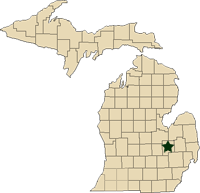 Southeast Michigan
Southeast Michigan